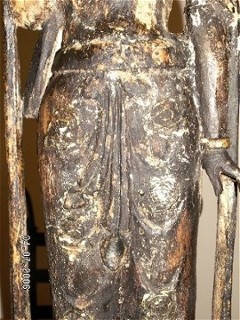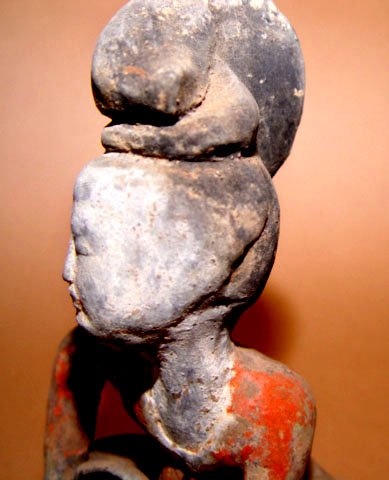
|
Subject:Old Kuanyin or Kannon
Posted By: Edward Shumaker Fri, Apr 07, 2006 IP: 68.155.238.122
I recently acquired this statue of Kuanyin, and was needing help in determining the age, as well as verifying if it is of Chinese or Japanese origin. It is carved wood with gesso applied relief: there are still traces of gold gilt, especially at the bracelet area. There is also a small ammount of red pigment on the crown area. It appears to be a temple statue that was damaged in a fire some time in its history. The wood is showing heavy signs of age: in the areas where the cracks appear, it has lost almost all trace of the original grain, and is also quite light for its size, suggesting heavy drying. I can tell it isn't teak or elm, but past that I'm not sure. I know it's an older style, due to elements of masculinity, such as the broad shoulders, thick hand, etc., such as was used in the earlier periods, and the eyes being partially opened. The size is 74 cm tall, 15 cm at the shoulder, 9 cm at the waist, 13 cm at the hip, and the widest part of the base is 23 cm.
Any help would be appreciated.
Ed





|
 Old Kuanyin or Kannon
Old Kuanyin or Kannon  ( China & Japan ) - Edward Shumaker - Apr 07, 2006 (06:53 PM)
( China & Japan ) - Edward Shumaker - Apr 07, 2006 (06:53 PM)  Re: Old Kuanyin or Kannon - njg - Apr 09, 2006 (03:42 AM)
Re: Old Kuanyin or Kannon - njg - Apr 09, 2006 (03:42 AM)  Re: Old Kuanyin or Kannon - njg - Apr 09, 2006 (04:31 AM)
Re: Old Kuanyin or Kannon - njg - Apr 09, 2006 (04:31 AM)  Re: Old Kuanyin or Kannon
Re: Old Kuanyin or Kannon  - Edward Shumaker - Apr 09, 2006 (04:52 AM)
- Edward Shumaker - Apr 09, 2006 (04:52 AM)  Re: Old Kuanyin or Kannon - njg - Apr 11, 2006 (07:23 AM)
Re: Old Kuanyin or Kannon - njg - Apr 11, 2006 (07:23 AM)  Re: Old Kuanyin or Kannon
Re: Old Kuanyin or Kannon  - Edward Shumaker - Apr 11, 2006 (03:20 PM)
- Edward Shumaker - Apr 11, 2006 (03:20 PM)  Re: Old Kuanyin or Kannon - njg - Apr 12, 2006 (02:01 AM)
Re: Old Kuanyin or Kannon - njg - Apr 12, 2006 (02:01 AM)  Re: Old Kuanyin or Kannon - fred - Apr 21, 2006 (06:52 AM)
Re: Old Kuanyin or Kannon - fred - Apr 21, 2006 (06:52 AM)  Re: Old Kuanyin or Kannon - fred - Apr 21, 2006 (06:54 AM)
Re: Old Kuanyin or Kannon - fred - Apr 21, 2006 (06:54 AM)  Re: Old Kuanyin or Kannon - Edward Shumaker - Apr 23, 2006 (04:33 PM)
Re: Old Kuanyin or Kannon - Edward Shumaker - Apr 23, 2006 (04:33 PM)  Re: Old Kuanyin or Kannon - njg - Apr 25, 2006 (04:10 AM)
Re: Old Kuanyin or Kannon - njg - Apr 25, 2006 (04:10 AM)  Re: Old Kuanyin or Kannon
Re: Old Kuanyin or Kannon  - Edward Shumaker - Apr 25, 2006 (04:56 PM)
- Edward Shumaker - Apr 25, 2006 (04:56 PM)  Re: Old Kuanyin or Kannon - njg - Apr 26, 2006 (02:11 AM)
Re: Old Kuanyin or Kannon - njg - Apr 26, 2006 (02:11 AM)  Re: Old Kuanyin or Kannon - Edward Shumaker - Apr 26, 2006 (09:47 PM)
Re: Old Kuanyin or Kannon - Edward Shumaker - Apr 26, 2006 (09:47 PM)  Re: Old Kuanyin or Kannon - njg - Apr 29, 2006 (05:43 AM)
Re: Old Kuanyin or Kannon - njg - Apr 29, 2006 (05:43 AM)  Re: Old Kuanyin or Kannon - Phillip Adams - Apr 30, 2006 (12:59 AM)
Re: Old Kuanyin or Kannon - Phillip Adams - Apr 30, 2006 (12:59 AM)  Re: Old Kuanyin or Kannon - Edward Shumaker - May 01, 2006 (05:39 AM)
Re: Old Kuanyin or Kannon - Edward Shumaker - May 01, 2006 (05:39 AM)  Re: Old Kuanyin or Kannon - njg - May 01, 2006 (10:31 PM)
Re: Old Kuanyin or Kannon - njg - May 01, 2006 (10:31 PM)  Re: Old Kuanyin or Kannon - njg - May 01, 2006 (09:55 AM)
Re: Old Kuanyin or Kannon - njg - May 01, 2006 (09:55 AM)  Actually...
Actually...  - James Wilson - Jul 09, 2008 (03:41 PM)
- James Wilson - Jul 09, 2008 (03:41 PM) 
_E_100.jpg)